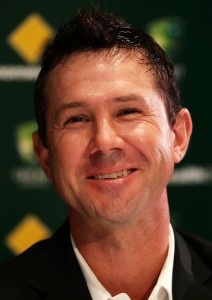
A gradual but inevitable descent into cricket-based loathing and bile.
The 51allout Bargain Basement Book Bonanza: Wisden Cricketers’ Almanac Australia, 2002-03
For whatever reason, the cricketing almanac seems to have died a death down under. Whereas in England the tradition of the yearly almanac continues unabated, along with other oddities such as spectators taking scorecards to domestic matches (or even attending domestic matches at all), the Australian public seems to have moved on. Perhaps it’s an indication of plunging literacy levels, or that Australians generally are suspicious of any information that isn’t either shouted at them by Mark Nicholas or turned into a cartoon of some kind.
The 2002/3 Wisden Cricketers’ Almanac Australia is, therefore, a look back at a time that has been lost forever. Back then there were usually no less than three competing almanacs on the market: Wisden, a Wide World of Sports Yearbook, and an ABC yearbook. Now you have to largely make do with an ABC magazine that Jim Maxwell puts together himself in his spare time with crayons and kraft glue, and, well, cricinfo of course.

The cover of the latest ABC Cricket Magazine is a particular favorite.
There was nothing particularly special about the 2001/2 season, it’s just that we happened to stumble across that particular Wisden at the local second-hand book store (next to a massive pile of Footrot Flats comics, naturally). That season was perhaps most notable for being when the Australian selectors realized that even though he was still doing a good job with the Test team, Steve Waugh wasn’t really adding much to the ODI setup anymore. Which goes to show just how far out of touch the ECB is these days really (approximately 12 years out of touch by our reckoning). Otherwise Australia smashed pretty much everyone. It was all very much business as usual.
There are, however, a few interesting glimpses into the future to be found within. Michael Clarke, then still a year or so away from his Test debut, is noted as being on the verge of exploding across the cricketing landscape. Mitchell Johnson, after being described by Dennis Lillee as a ‘once in a generation’ bowler, made his long awaited domestic debut that season. Brad Haddin was just another domestic gloveman who had to make do living in Adam Gilchrist’s shadow, Ryan Harris was considered more an all-rounder than outright pace bowler, while even only eleven games into his first class career, Chris Rogers was already being described as a street fighter.

Probably not this Streetfighter though.
But the most interesting part of the book is a short piece by Australian journalist Greg Baum, exploring the question of whether the (then) Australian cricketing empire could last the distance. Naturally, given the manner in which Australian cricket imploded so quickly after the 2006 Ashes, we started reading the article in expectation of a tale foreboding doom and despair. Interestingly, there is none to be found. Australian cricket is declared to be in the very best of health, with no reason whatsoever to believe that its time of domination would soon come to an end.
Despite drawing the obvious comparison between the retirements of Greg Chappell, Rod Marsh and Dennis Lillee that led to Australian cricket’s long slump during the mid 80s, Baum claimed that the same wouldn’t occur when Steve Waugh, Shane Warne and Glenn McGrath et al stepped down in the foreseeable future. The argument is that not only were the selectors far better prepared for this, but so were the other players too. Baum claimed that the greater professionalism of modern day players would mean those above would not outstay their welcome, while their absence would not overly disrupt their former teammates. A large pool of experienced players, built up by the selection panel ahead of time, would ensure a smooth turnover, and Australia would simply march on with the same ruthless efficiency.
Even with the benefit of hindsight it’s hard to follow this logic. Baum doesn’t name any of the players who would so seamlessly step into the void, rather he assumes that when the time came, they simply would be there. Far more prescient is the quote from Rod Marsh (now Chairman of Selectors), who even then was cautioning that Australia’s batting stocks were thinning at an alarming pace.

We assume he simply wasn’t referring to Ponting’s hairline.
Baum is also largely dismissive to the threats posed by other nations. South Africa’s development, it is claimed, was stymied by the influence of internal politics, whilst England were embarking on yet another rebuilding phase that could potentially last decades (till they hit upon the shortcut of poaching from South Africa’s junior teams). The biggest threat to Australia’s dominance was, conversely, the distraction of ever increasing player remuneration and the machinations of the ICC.
In hindsight this seems a fairly innocent time, before the emergence of T20 cricket and the rise of the BCCI. Back then Australia’s continuing dominance of the cricketing landscape seemed an inevitability. It’s not surprising really that journalists such as Baum were so unaware of the car crash that was awaiting them down the road. So you can’t really blame Baum for getting things so badly wrong. Besides, even he could never have predicted how hilariously incompetent Andrew Hilditch would prove to be.

No Comments
Post a Comment